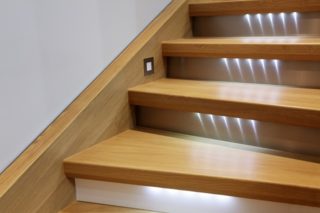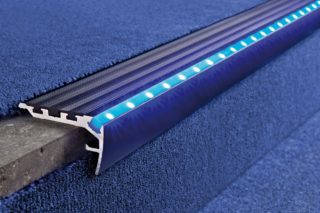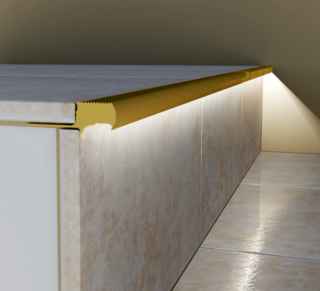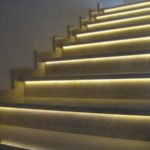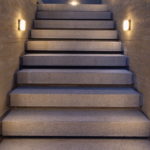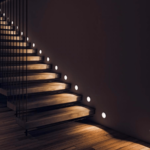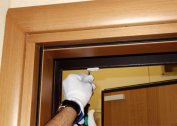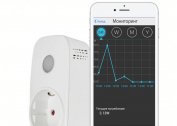The illumination of stairs through special illuminators enhances the decorative expressiveness of interiors and increases the safety of using a staircase. Modern technologies allow you to get original visual effects, thanks to which this structural element is perceived quite differently. Anyone can do this if they become familiar with the principles of forming the lighting design for stairwells in a house or in a country house.
Ways to illuminate stairs on steps with a motion sensor
You can control the lighting of the entire staircase or its individual sections manually and in automatic mode. In the first case, it is turned on using a conventional keyboard device, and the second is typical for household systems classified as “smart home”. If desired, smart staircase lighting can be used not in the entire structure, but only on individual structural elements.
Auto backlight
Automatic lighting control is a convenient option that simplifies the operation of lighting equipment. There are several ways to implement this feature:
- by installing a sensitive sensor that responds to movement in the designated area;
- sound effect on the acoustic sensor (clapping, for example, or voice command);
- light touch to the elements of the staircase.
In this case, modes with constant illumination or with a variable intensity of the light flux are possible. It also provides the option of smoothly turning the illuminators on and off, or the same, but with a time delay.
The most widely used LED staircase lighting, attracting the attention of users with its efficiency and compactness. By the method of supplying power to the lighting elements, the zone lighting systems are divided into wired and wireless. The latter are used in conjunction with expensive additional equipment and can operate over the air or over Wi-Fi. To connect a conventional (wired) backlight, you will need to purchase a special cable.
The principle of operation of automatic staircase lighting
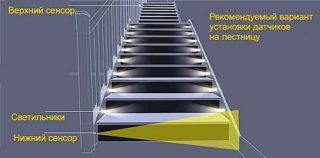 Unlike conventional lighting devices that are manually switched on, automatic illumination is activated only when approaching a person’s staircase. To do this, the lighting control system is equipped with a motion sensor and programmable devices that close and open the supply circuits, depending on the situation.
Unlike conventional lighting devices that are manually switched on, automatic illumination is activated only when approaching a person’s staircase. To do this, the lighting control system is equipped with a motion sensor and programmable devices that close and open the supply circuits, depending on the situation.
A typical staircase illumination on steps with a motion sensor may contain two sensing elements (on the first and last steps of the structure). It is triggered to turn on when a person approaches the staircase and to turn off - when leaving it.
For flights of flights with long flights it is allowed to install more sensors. This opportunity allows you to implement more complex schemes, one of which consists in alternately highlighting different levels. At the same time, it seems that the lighting moves after the person along the entire route.
Rules for choosing lighting equipment
As the backlight elements, it is best to use LED devices combined in long tapes or mounted separately.To the taste of the owner of the home, it can be single-color products, or multi-color RGB elements. The latter glow with shades of all colors, initiated by the command of the controller built into the system.
LED illuminators are characterized by low power consumption, their life expectancy is significantly higher than the same indicator for ordinary daylight or halogen lamps. Other advantages of this type of lighting include the fact that they operate on a low voltage of 12 (24) volts. Thanks to this, the installation and operation of the backlight based on LEDs is absolutely safe and does not require special protective equipment (for example, grounding).
Preparing to set the backlight
Before arranging the illumination of the steps of the stairs with a motion sensor, preparatory work is carried out, consisting in drawing a diagram of the connection of lighting devices. A preliminary calculation will also be required to determine the length of the LED strip and the number of mounted motion sensors.
In the estimate for the development of the lighting system, controllers with drivers should be taken into account, allowing the possibility of updating the algorithm for turning on the LEDs. The specialists who are part of the well-known Arduino platform are very popular with specialists. Its distinguishing feature is functional flexibility and the ability to choose ready-made software and hardware solutions.
Anyone who is not even familiar with programming elements can deal with the assembly order of such a kit. At the preparatory stage, you will need to select a power supply suitable for power and a set of connecting wires to it. For the normal functioning of the system, it is enough to stock up on a simple converter for an output voltage of 12 or 24 Volts. No additional electrical equipment is required.
Do-it-yourself installation of staircase lighting on steps
The installation procedure for the system lighting of stairs based on LEDs is presented in the form of the following sequence of actions:
- The LED strip is cut into pieces of a pre-calculated size.
- A connecting connector with wires already soldered to it is attached to the contact spots of each of them (observing the polarity).
- The surfaces of the steps on which the LED blanks are mounted are cleaned of dust (dirt) and degreased with acetone.
- The segments of tapes themselves are fixed due to the self-adhesive layer on the back side, for which a protective film is removed from it.
- The power supply wiring is hidden in the free niches that are always available in the staircase design.
- They also prepare places for the installation of motion sensors and other included electronic components.
Upon completion of the installation of tape light sources, they proceed to the final stage of assembly of the automatic system. First of all, power supply lines to the converters are designed. If necessary, devices are installed in them that protect the working circuits from overloads and short circuits. For these purposes, typical circuit breakers for current (AB) are used, designed for the appropriate setting.
Converters or power supplies, as well as controllers are mounted in separate boxes in places where they can be freely accessed. The connecting wires are connected to the connectors intended for them, the power supply is connected to the household power supply.
At the final stage, the system is tested, during which the detected malfunctions are identified and eliminated. If necessary, the backlight control program is adjusted.
Lighting Specifications
Lighting devices consist of a light source (lamps of one or another class) and special fixtures that redistribute light fluxes.In addition, they have fixtures of a special design that protect the lamps from mechanical deformation, and there are voltage-conducting conductors.
According to the generally accepted classification, all devices suitable for lighting stairs are divided into three main classes:
- conventional lights;
- searchlights;
- LED strip.
- LED strip
- Floodlights
- Fixtures
The first two positions are products intended for zonal installation on the stairs and creating a concentrated luminous flux. In contrast, LED strips are mounted in the form of linear backlight elements that provide a distributed picture of lighting.
Main characteristics of the used fixtures and LED lamps:
- the nature of the distribution of light spots (KSS light intensity curves);
- flow distribution coefficient;
- efficiency or luminous efficiency.
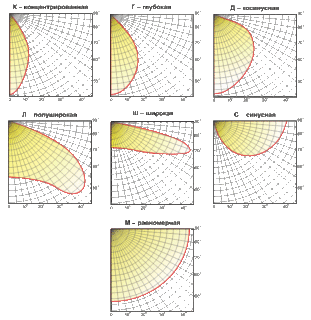 The last parameter refers to the ratio of the luminous flux in the lighting zone to the same indicator near the light source.
The last parameter refers to the ratio of the luminous flux in the lighting zone to the same indicator near the light source.
In accordance with the distribution curves of KSS, all known lighting devices are divided into several types:
- concentrated in a specific area;
- deep (far) lighting;
- cosine form;
- with wide and narrow grip;
- with uniform distribution of light fluxes.
According to the type of power supply, lighting devices are divided into two classes: models connected to a 220 Volt network, and samples designed to operate from voltage converters (12 or 24 Volts).
